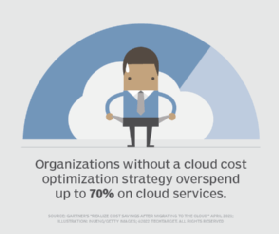
twobee - Fotolia
Gain a broad view of cloud optimization
Cloud optimization is a broad discipline that involves much more than just cost. Learn why performance, reliability and sustainability should also play a role in an optimization strategy.
Many IT professionals tend to speak of cloud optimization in a singular form, as if there is only one way to do it. In reality, there are multiple facets of optimization in the cloud, including ways to improve cost, performance, reliability and even environmental sustainability.
The different optimization goals mostly tend to reinforce each other, so it's helpful to think broadly about optimization to get the most out of your cloud strategy. Use this article to familiarize yourself with the various types of optimization and learn how they fit together so you can make your cloud environment more efficient.
Cost optimization
For most organizations, lowering costs is the most important component of cloud optimization. Compared to on-premises infrastructure, it is easy to overspend in the cloud when you allocate more resources to a workload than it requires.
This problem is compounded by the fact that cloud pricing models tend to be extremely complex, with a menu of different fees charged for services at rates that vary between regions -- or even times of day.
To address this challenge, use cloud vendors' basic cost monitoring tools, such as AWS' Cost Optimization Monitor and Azure cost alerts. These tools help an organization understand where it's spending the most money and can alert them to higher-than-necessary expenditures.

However, cloud vendors don't go out of their way to help users spend as little as possible on their platforms. They also don't provide tools that work across environments for hybrid or multi-cloud architectures. That's why cloud cost optimization strategies often incorporate a range of methodologies and tools, including third-party offerings that work across various cloud architectures instead of being native to one vendor's platform.
Performance optimization
In the cloud, performance optimization means making sure applications and services run as quickly as possible.
Like cost, performance is a complicated topic that depends on a variety of factors. One important facet to consider is the design of your cloud architecture. For example, architectures that require frequent data transfers between cloud regions or distinct clouds are likely to deliver poorer performance due to network bottlenecks and latency.
The type of cloud services you select also affects performance. For some types of workloads, serverless functions may deliver better performance than a standard VM, because the resource allocations of a VM are likely more limited.
The underlying efficiency of your code also has a critical influence on cloud performance, even though the code is not explicitly tied to the cloud. Regularly test the performance of new application code prior to deployment.
Reliability optimization
Cloud-based workloads can become unavailable due to failure of the cloud that hosts it or because of a problem with the workload itself. To maximize application reliability, mitigate those risks.
Redundancy is the go-to strategy to optimize for reliability. This is when enterprises deploy multiple instances of the same workload in different clouds or in different regions of the same cloud. However, those types of safeguards can quickly rack up hefty bills. You must balance your redundancy goals with your cost optimization goals to get the best results overall.
Sustainability optimization
Improving the carbon footprint of cloud workloads hasn't traditionally been a consideration for many organizations. But that is changing as concerns about environmental sustainability grow -- and as vendors vie to claim the title of greenest cloud. As a result, organizations are paying increased attention to the ways their architectures and configurations affect the amount of energy their IT workloads consume.
Fortunately for organizations that seek to build eco-friendly clouds, practices that maximize sustainability tend to go hand-in-hand with other types of cloud optimization. If you optimize for performance, for example, you will probably also end up with a cloud architecture that consumes fewer carbon resources.
Bring the different types of cloud optimization together
Each type of optimization serves a different purpose and requires its own set of tools or strategies. It might seem natural, then, to treat them as distinct processes -- and many organizations do.
Yet, that approach will likely leave your team with optimal results in one area but issues in another. Improving your cloud in a holistic fashion requires more planning and careful implementation upfront. This ensures that you don't undo the progress in one area while achieving optimization in another.
There is no one-size-fits-all approach to this problem. Balance decisions with your company's priorities and objectives. For example, you might be willing to spend more if it means your application has higher availability and lower latency. Still, organizations that approach optimization with a multifaceted set of goals are best positioned to build the most optimal clouds in the long run.






